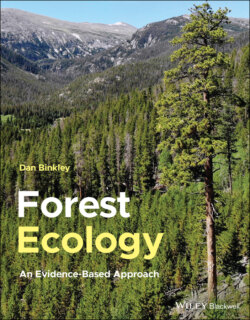Читать книгу Forest Ecology - Dan Binkley - Страница 28
The Futures of the Tree and the Forest Will Depend on Both Gradual, Predictable Changes and Contingent Events
ОглавлениеThe future is largely unpredictable for individual trees, but some predictions may have a high probability of coming true. The dominant situation enjoyed by the tulip poplar featured in this chapter would generally predict steady growth into the future. Growth might even increase as neighbors are suppressed. Dominant trees of this species may live for more than two centuries, and such a long lifespan provides opportunities for dispersing millions of seeds.
A long lifespan also increases the odds that the tree will experience rare weather events. For example, a severe drought with a probability of occurrence once in 100 years might severely challenge a tree's survival. A tree that lives only about five decades would have a 60% chance of never experiencing a 100‐year‐magnitude drought (if weather is random), whereas a tree that lived two centuries would have an 87% probability of experiencing at least one 100‐year drought.
A host of other future factors are more difficult to assign probabilities. The death of a neighboring tree may suddenly increase the supplies of resources available to this tree, or the falling neighbor may collide and uproot this tree as well. Lightning tends to kill large trees more often than smaller trees. Outbreaks of insect populations and fungal diseases influence the long‐term development of many forests. The climate experienced by this tree (and its ancestors) may not continue into the future. Novel pests may arrive in the forest, as a result of widespread transport associated with world‐wide travel by people and materials. The future of the tree may also depend very heavily on choices made by people; a large tulip poplar tree can be transformed into thousands of dollars‐worth of furniture and other products.
Some changes in a forest tend to be cyclic, with repeating patterns of species and growth rates following major events. The major recolonizing species will have predictably high tolerance for full sunlight and rapid early growth, whereas trees that remain after two centuries will likely grow slowly and the community will include trees that thrive under shady conditions. Other changes are clearly not cyclic, and lead us to expect that the future forests in the Coweeta Basin will not be simple analogs of past forests (Jackson and Williams 2004). The development of forests responds to changes in climate, and climatic patterns (and the responses of trees and species to these patterns) have long legacies (Kardol et al. 2010). Changes in future climates may have modest effects on the forests compared to novel insects and diseases. The chestnut blight removed the dominant tree species from the Coweeta forests, and the hemlock wooly adelgid decimated the population of eastern hemlock trees. What will be the legacies of the loss of almost all the chestnuts and hemlocks trees from Coweeta's forests? Might we be able to predict the response of surviving species to the disappearance of hemlock, based on the patterns from 6000 years ago when eastern hemlock experienced another decline, or will other factors (such as changing climate) limit the ability of the past to illuminate the future? We might speculate about how other species will take advantage of reduced competition from these species, but the actual impacts will include the ecological legacies of changes in soils and in animal communities. Forests often respond to more than one event; future forests develop from the combined legacies of historical events (such as losses and gains of species) in combination with current conditions. Warming climate, rising atmospheric concentrations of carbon dioxide, and other factors will influence future forests, shaping the legacies of the losses of chestnuts and hemlocks. Will new species of exotic insects arrive and remove other tree species from Coweeta's forests?
The future development of a tree, and of a forest, derives from the gradual accumulation of routine changes, such as annual increases in height and mass of stems. Over limited periods, these gradual, expected trends are punctuated by contingent events that are largely unpredictable, such as hurricanes and invasions by exotic pathogens. Humans are another force for change in forests, through direct management (typically favoring some species over others, often limiting the opportunity for old trees to develop) and indirect activities (such as nutrient enrichment of rain, air pollution, and climate change).
Given all these forces of change, how can we predict future forests? The short answer is simply that we cannot predict future forests with much confidence. The longer (and more useful) answer is that we can indeed develop insights about the likely forests of the future, if we understand some of the basic features that have shaped forests in the past, and how ecological interactions will combine to shape future forest.
